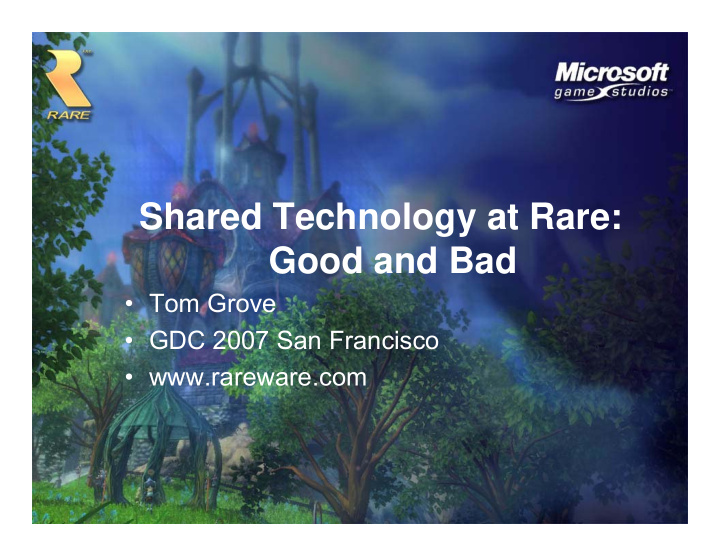



Shared Technology at Rare: Good and Bad • Tom Grove • GDC 2007 San Francisco • www.rareware.com
Outline • Who are Rare? • The Shared Technology Group • Lessons Learnt • Was it worth it? • Summary • Questions?
Rare Ltd • Part of MGS • Creatively Lead • Multi Title – 2-4 360 teams – Prototype teams – DS / Handheld Team • Support Teams – Shared Technology Group – Audio Department – Art Asset Group
Shared Technology Group • Background • Motivation • Development – Initial plan and focus • Review of initial approach
STG: Background • History – “RnD” Setup in 1999; 5-6 inexperienced developers, 1 lead – Currently 20 developers, 2 leads and producer • Used by all console titles since 2000 – First title: Starfox ( Game Cube ) – Six major titles so far
STG: Motivation • Why was the group setup? • Reduce Duplication – Over five different engines on N64 – Development cost expected to increase • Disseminate best practice – Best of breed • Share research • Support art and design
STG: Initial Plan • Interview teams to see what they do • Develop a shared engine (“r1”) • Ready for teams moving from N64 to GC • Game development model
STG: Initial Focus • Response to perceived problems • Strong focus on art-pipeline – Reflection of creativity lead development – Respected art tool in previewer – Artist authored shaders • Emphasis on runtime performance – Expectations from single platform history – ow-level animation
Review • Successes – Accurate art tool reflection – High runtime performance • But key weak areas – Development Process – Distribution and Support – Client Relationships • We examine these next
Technology Development Then and Now
Technology: Then • Artist directed technology – Confused communication • Focus on “next-gen” features circa 2000 – High-order surfaces, physics, ... • Too much emphasis on runtime – Single platform culture – Naïve content expectations
Technology: Then • Reactive development – Polish and optimisation postponed – Favours vocal minority • Too little experience – Code quality – Focus on “cool” features
Technology: Now • Pro-active Coordination with teams – Agile development ( scrum-like ) – Transparent “ring-fencing “ of capacity • Producer • Peer code reviews • Components based • Technology is not the hardest part…
Component Based • Not building an engine – Clients already had engines .. • Set of independent components • Allows for middleware • Clients take suitable components • Components support customisation – Important in getting support of graphics engineers
Component Catalogue • Animation • Tools – Asset management • Rendering – World building • Art tool support – Asset previewer – Plug-ins • Fonts – Exporters • Data reflection • Art-pipeline • Collision detection – Max and Maya • Maths • Profiling
Component Use • Kameo: Elements of Power – Used all components, but with custom lighting • Perfect Dark Zero – Custom Deferred Renderer built on top of existing pipeline components – Havok for physics and collisions • Viva Pinata – Only animation and low-level components – Co-existed with an existing renderer
Distribution and Support Then and Now
Distribution and Support: Then • Did not really consider distribution • Initially planned quarterly releases • But taking a new version painful – Development cycles out of sync – Asset and code build times • Poor model for team code changes – Re-integration of local changes
Distribution and Support: Now • We see ourselves as much a service as a product – “fire and forget” does not work for middleware • Improved build quality • Deprecation policy • Better source control tools ( source depot ) • Better customisation • Case officers
The role of the case officer • Developer allocated to each game in production – Prototypes do not generally need one • Bridge between the game team and STG – Accountable developer • Has a personal stake in the product • Responsible for arguing the clients case – On-site customer in agile methodologies
Client Relations Then and Now
Client Relations: Then • Critically important • STG did fit into the development culture – Competitive teams • Poor feedback between teams and STG • An Us-vs-Them situation developed
Client Relations: Now • Involve teams in monthly sprint planning • Quarterly product review meetings • Game teams mentor STG developers • Case officers again • Informal monthly technical lead meetings –with biscuits! • All new starts come through STG –Removes the “us-and-them” distinction
Was it worth it? • Modest team sizes ( ≈ 30 ) outside of crunch • Three titles shipped in last two years • Game teams less technology focused • Improved development atmosphere • Preserved core values – Still art / design lead – Still have strong team identities
Future • Binary changes still a problem – Case officers feel the pain • Documentation – Recruitment is difficult • Tools still need work • Build times a problem – How to balance re-factoring against cost to clients?
Summary: Lessons Learnt • Client Relationships – Critical to build culture where good will is assumed on both sides – Face to face meetings – Case officers • Support and Distribution – Software as service • Development – components – Agile development
Questions? tgrove@rare.co.uk
Recommend
More recommend